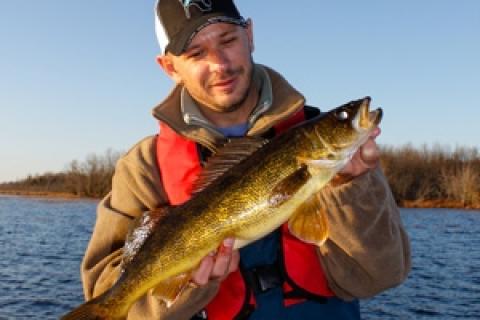
 Fall time signals a change in the attitude of walleye. With the onset of winter just around the corner, now is the time for walleye to begin gorging on baitfish and other food sources in order to build up fat reserves. These needed nutrients are necessary to get them through the harsh and cold winter, and also to prepare them for the upcoming spawn.
Fall time signals a change in the attitude of walleye. With the onset of winter just around the corner, now is the time for walleye to begin gorging on baitfish and other food sources in order to build up fat reserves. These needed nutrients are necessary to get them through the harsh and cold winter, and also to prepare them for the upcoming spawn.
It is feast or famine time for northern walleye. Are you ready to get in on the action?
Where to Look
Finding the walleyes of fall can be a simple task, as locations are quite precise and straightforward. The first thing to do is limit all of your fishing to water that is less than 20 feet deep. Fish move shallower as the water grows cold and most of my angling actually takes place in water less than fifteen feet deep. Rivers, shoals, humps and islands all provide key areas for walleye to congregate at. These structure points provide an adequate food source and also an excellent staging area in preparation of the forthcoming spawn.
Current areas act as a magnet for walleye, enabling both anglers on shore and in boat to cash in on the action. Concentrate on weed/rock transitions and well-defined weedlines that are made up of healthy green weeds.
The Graveyard Shift
Night fishing for walleye is a technique that positively shines when summer turns into fall. Due to their light sensitive eyes, walleye will flood the shallows come nighttime, searching for an easy meal with their well-honed vision. The best technique to employ at night is to start shallow, and work progressively out into deeper water.
Crankbaits are your best choice during these optimum conditions as they can cover water quickly, and "match the hatch" perfectly. Choose cranks that have a long profile, and don't be afraid to go big when picking your baits. Lures between 5 and 7 inches are the norm in the fall, and will certainly produce above-average size fish.
Casting and trolling are two productive techniques to utilize when chasing walleye through the night. Casting will allow you to work the area thoroughly, however, trolling will enable you to cover a larger area.
Riggin' for 'Eyes
Downrigging for fall walleye can be a dynamite technique that can produce big stringers. Downriggers allow an angler to present their lures at an exact depth — a situation that rarely happens when anglers troll without a cannonball. Depending on the depth of the baitfish or the structure you are fishing, raising and lowering your presentation is as easy as a flick of a switch or a turn of a handle. Used in conjunction with your onboard electronics, downriggers allow you to stay with the roaming schools of walleye, and at their preferred depth.
Another great tool for the fall are planer boards. These trolling companions allow you to get your lures out and away from the boat — a helpful protocol for finicky or prop-shy fish. Experiment with speed, trolling routes and depth, and the pieces of the puzzle will certainly come together.
- 2671 views

